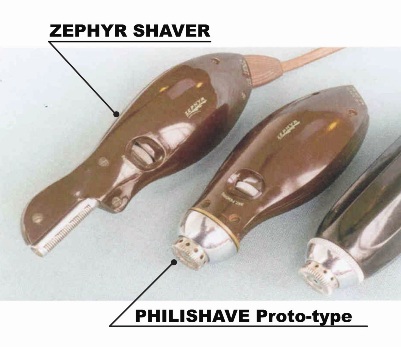■THE BEGINNINGS OF THE SHAVER
Do you know when and by whom the electric shaver (electric razor) you use every morning was made?
■Zephyr Shaver 

The Zephyr Shaver featured a unique spiral rotary blade. Unlike most other shavers influenced by the Schick Shaver, which had a vertical body with the shaving head on top, the Zephyr Shaver had a horizontal housing with a horizontally elongated spiral rotary blade. This relationship is similar to that between a safety razor and a straight razor.
・When was it released?

An article in the February 1938 issue of Boxoffice magazine, a publication related to movies, entertainment, and theaters, mentions that the parent company, GTE (General Theaters Equipment Corp), announced its entry into the shaver business with the Zephyr Shaver alongside the launch of a new projector product. The article states, "GTE (General Theaters Equipment Corp) has released an electric shaver through its subsidiary, Zephyr Shaver Corp. This indicates GTE's intention to expand its business scope beyond the motion picture industry."

Additionally, it is known that Mr. Horowitz, who developed the Philishave for Philips, reused the body of the Zephyr for his first prototype. According to records, Philips purchased a sample in 1937, and Mr. Horowitz developed the rotary head for the Philishave in 1937, producing a prototype around 1938. From these facts, it is believed that the Zephyr Shaver was released in 1937.
・Mechanism and Structure



This is an advertisement for the Zephyr Shaver from the July 1938 issue of Popular Science magazine. As seen in this advertisement, the principle of its rotary blade is the same as that of the current Hitachi rotary shaver. The 'prototype' of modern shaver blades was almost entirely covered within ten years of Schick inventing the electric shaver (with one exception, which will be discussed another time). The Zephyr's rotary head had four spiral blades rotating within a sleeve with slits. The rotation speed was 250 revolutions per second, or 15,000 rpm, which is quite high even by today's standards.
It had a standard motor of the time with a flywheel for starting, and unlike other competitors, the rotary blade was directly attached to the motor shaft. The four spiral blades were hollow and fitted with a groove at the base to prevent them from coming off the rotation shaft. The power source was standard for the time, operating on both AC and DC (110V-120V AC or DC). The price was $15, the standard for electric shavers at the time. Considering the currency value difference of 200 times, $15 then would be equivalent to about $300 today, making it quite a high-end product.
Although it later moved to Hollywood, it is said that the American film industry began when Vitagraph set up a studio in the Brooklyn area of New York in the early 1900s. Perhaps due to the parent company GTE's main business being the film industry, Zephyr Shaver Corp.'s address was 92 Gold Street, Brooklyn, New York. This was unique compared to many competitors based in Connecticut. While companies like Remington advertised in large-format magazines like LIFE and LOOK, choosing Popular Science magazine was also unique, emphasizing the new principle of the shaver.